 |
August 2018
|
August 2018 // Volume 56 // Number 4 // Ideas at Work // v56-4iw2
Surfing Waves of Change: Building Organizational Capacity in Extension Through Leadership Programs
Abstract
Leadership development is a viable solution to equipping Extension employees for administrative responsibilities at earlier career stages. Extend Advanced Leadership Training Program (Extend) is a University of Georgia Cooperative Extension cohort-based initiative proving to be a catalyst for enhancing the leadership skills of Extension personnel. This article addresses data from a mixed-methods study of the Extend program, which revealed findings on how "changing self" and "changing others" resulted in personal and professional growth within the cohort participant study sample.
Introduction
Tidal waves of staffing change keep rolling. More than 51% of employees in the U.S. workforce are looking for new jobs and only 33% of employees feel engaged at work (Gallup, 2017). It is evident that employers must work harder to develop and retain talent. Amid staffing, economic, and societal changes, leadership development is used to engage employees and train upper management, causing leadership education spending in U.S. companies to rise to $15.5 billion in 2013 ("Bersin by Deloitte," 2014).
Cooperative Extension uses cohort-based leadership programs to train staff and adapt to organizational changes. However, there is limited research identifying the impact of such initiatives. This article describes findings from a study on the Extend Advanced Leadership Training Program (Extend), a 2-year University of Georgia program, and provides ideas to inform similar initiatives.
Program Description
Constructed as a response to the leadership gap in the University of Georgia's Extension employee base, Extend enhances employee development in key competency areas (advocacy, communication, conflict management, expansion of Extension capacity, interpersonal skills, strategic management, team dynamics). Extend supports Paxson, Howell, Michael, and Wong's (1993) recommendations that Extension leadership programs focus more on diversity, understanding (versus doing), and transformational leadership. The 16-person 2014–2016 cohort completed seven in-state sessions, a mentoring experience, and an international immersion in Ecuador. Participants also worked together to complete self-directed projects designed to enhance organizational capacity. Built on adult learning principles (Knowles, Holton, & Swanson, 2005), sessions were often 3 days and 2 nights and occurred at various Extension research stations across the state. Knowledgeable speakers ranged from leadership consultants to Extension and university administrators.
Method
After program completion, the 2014–2016 cohort members were given an opportunity to participate in a mixed-methods study measuring knowledge and behavior changes. We designed and administered to the group a 14-item questionnaire, with eight Likert-scale closed-ended response statements (i.e., strongly disagree, somewhat disagree, neither agree nor disagree, somewhat agree, strongly agree) and six open-ended questions. Fourteen of the 16 participants completed the questionnaire, for an 87% response rate. The purpose of this article is to focus on participant responses to the eight Likert-scale statements as they provide information that is most applicable to similar programs. Other questionnaire items were specific to the logistics of Extend's session topics and alumni opportunities.
We analyzed the questionnaire responses and extracted themes using the constant-comparative method (Charmaz, 2006). We then selected five participants at random to provide comments through 45-min face-to-face semistructured interviews. We asked questions from the original questionnaire during interviews and then compared responses to the quantitative data and identified themes. In the interview response data, we discovered two themes involving categories comprised of the initial codes.
Findings
The two themes we identified from the questionnaire and interview responses were changing self (working with leadership and seeing the global picture) and changing others (experiencing Extend's alumni network). These themes holistically summarized participants' experiences in the program.
Changing self, the more common theme, captured the change that occurred within the participant as a direct result of Extend. Seventy-one percent of participants (f = 9) reported increased confidence in their leadership abilities, a better understanding of their leadership behaviors, and an application of Extend knowledge to their existing jobs. Approximately 86% (f = 12) believed they would be more effective leaders as a result of the program. Participants also highlighted the importance of knowing one's strengths and weaknesses while also understanding Extension's expectations, diversity, and resources. Visual representations for data related to this theme are shown in Figures 1–5.
Figure 1.
Responses to "Participating in Extend Has Given Me More Confidence in My Leadership" (n = 14)
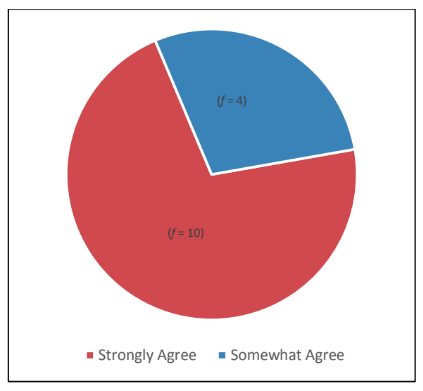
Figure 2.
Responses to "My Understanding of Myself as a Leader Increased as a Result of Participating in Extend" (n = 14)
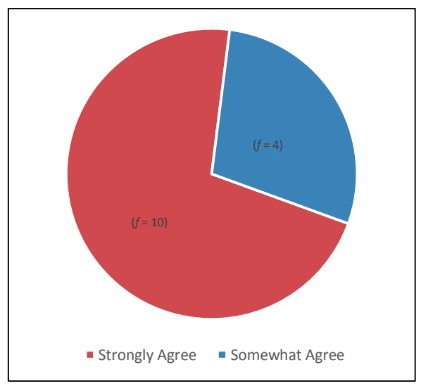
Figure 3.
Responses to "I Believe I Will Be a More Effective Leader as a Result of Participating in Extend" (n = 14)
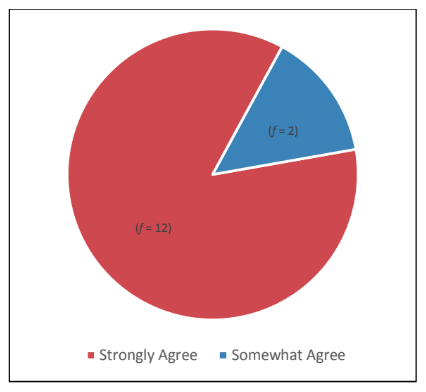
Figure 4.
Responses to "I Have Implemented Learning from Extend in My Current Role" (n = 14)

Figure 5.
Responses to "I Behave Differently at Work Because of My Experiences in Extend" (n = 14)
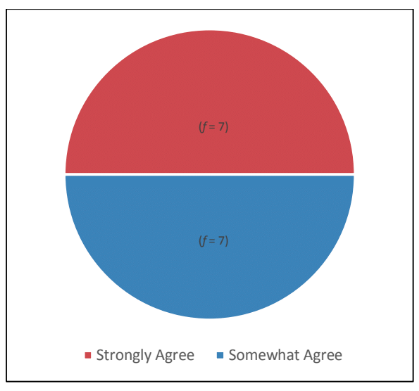
Changing others, the second theme, revealed that participants desired to share their learning with others. Sixty-four percent of participants understood how to work with others better, and approximately 79% were more comfortable working with others outside their departments. Participants also reported that communication with others was the competency most significantly affected by their Extend experience. Qualitative data collected for this theme show that participants' understanding of organizational scope and cultural sensitivity increased. Visual representations for data related to this theme are shown in Figures 6–8.
Figure 6.
Responses to "My Understanding of How to Work with Others Increased as a Result of Participating in Extend"
(n = 14)

Figure 7.
Responses to "I Feel More Comfortable Working with Others Outside of My Department as a Result of Extend"
(n = 14)
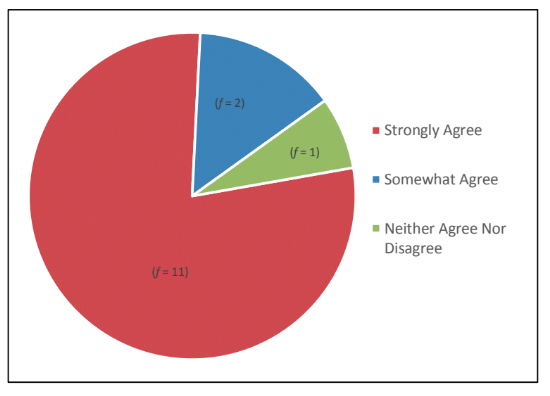
Figure 8.
Responses to "Choose 3 Areas of Leadership Development That Were Most Meaningfully Impacted Through Your Experiences" (n = 14)
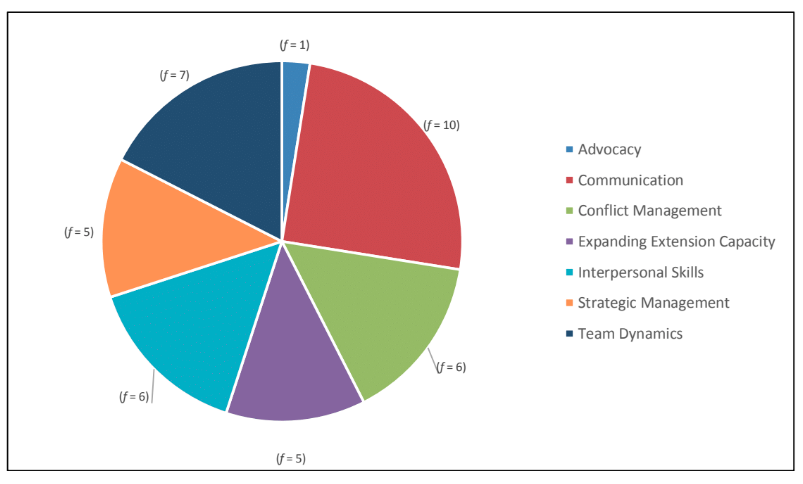
Recommendations for Extension Leadership Programs
Often, Extension employees are not officially trained for leadership and management positions; rather, they are promoted because they perform well in subject-matter areas (Ladewig & Rohs, 2000). Societal changes and organizational challenges, such as turnover and retirement rates (Bowen-Ellzey, Romich, Civittolo, & Davis, 2013), make leadership development academies and cohort-based programs increasingly important solutions for strengthening Extension's leadership pipeline (Strong & Harder, 2009). Extension needs employees who are poised for leadership responsibilities at earlier stages in their careers. Leadership development programs can serve as avenues for preparation while also increasing employee engagement.
The aforementioned data provide a snapshot of an effective program that upholds what Extension values in leadership initiatives and what professionals need to fill in knowledge gaps while performing in a rapidly changing society. Extension leaders can intentionally prepare professionals for success instead of simply hoping employees learn best practices handed down from their predecessors (Ladewig & Rohs, 2000). Therefore, we suggest considering the following questions when creating or enhancing a leadership development program:
- What is the purpose of the program? In what ways does that purpose serve larger organizational needs?
- What is the budget?
- What group size is best for effective collaboration and learning?
- What areas of professional development need to be explored to fulfill the program's purpose?
- In what ways is the curriculum design participatory, reflective, and applicable?
- What cultural competencies are needed to help learners develop?
- How does this program address responses to change?
- How can employee engagement be enhanced through this program?
- What is success, and how will it be measured throughout the process?
Extension programming "has always embodied adult education's teaching–learning process, where the goal is not to tell people what to do but to teach them how to solve problems and learn from others" (Zacharakis, 2008, p. 15). Our research findings echo this sentiment. Individuals are effective when they see themselves as leaders, act to understand and develop their leadership capacities, and implement behavioral changes through communal interactions with those around them in a safe environment. Furthering an understanding of self and others, leadership development can help engage employees, train them for future leadership roles, and support organizational structure so that Extension can effectively ride the waves of change.
References
Bersin by Deloitte research shows US leadership development spending up again 14 percent to more than $15 billion in 2013. (2014, May 14). Retrieved from http://www.prnewswire.com/news-releases/bersin-by-deloitte-research-shows-us-leadership-development-spending-up-again-14-percent-to-more-than-15-billion-in-2013-259213531.html
Bowen-Ellzey, N., Romich, E., Civittolo, D., & Davis, G. (2013). Change is inevitable: How field specialist positions can help meet the challenge. Journal of Extension, 51(3), Article 3COM1. Available at: http://www.joe.org/joe/2013june/comm1.php
Charmaz, K. (2006). Constructing grounded theory: A practical guide through qualitative analysis. London, United Kingdom: Sage.
Gallup (2017). State of the American workplace. Retrieved from http://www.gallup.com/services/178514/state-american-workplace.aspx
Knowles, M. S., Holton, E. F. III, & Swanson, R. A. (2005). The adult learner: The definitive classic in adult education and human resource development (6th ed.). San Diego, CA: Elsevier.
Ladewig, H., & Rohs, F. (2000). Southern Extension leadership development: Leadership development for a learning organization. Journal of Extension, 38(3), Article 3FEA2. Available at: https://www.joe.org/joe/2000june/a2.php
Paxson, M. C., Howell, R. E., Michael, J. A., & Wong, S. K. (1993). Leadership development in Extension. Journal of Extension, 31(1), Article 1RIB2. Available at: https://www.joe.org/joe/1993spring/rb2.php
Strong, R., & Harder, A. (2009). Implications of maintenance and motivation factors on Extension agent turnover. Journal of Extension, 47(1), Article 1FEA2. Available at: https://www.joe.org/joe/2009february/a2.php
Zacharakis, J. (2008). Extension and community: The practice of popular and progressive education. New Directions for Adult and Continuing Education, 2008(117), 13–23. doi:10.1002/ace.282




